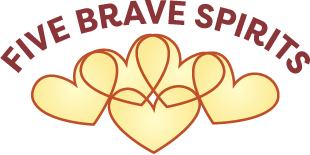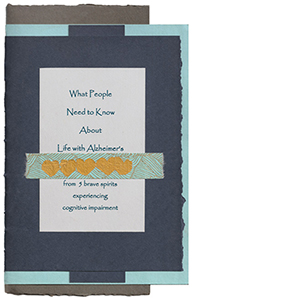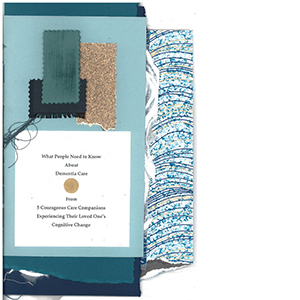The Booklets: Five Brave Spirits Backstory
Joyce Calvert was always right there for her wife Jane Dahlgren. Always anchored by Jane. Always advocating for Jane, who was living with Alzheimer’s disease. Then the pandemic came. Pandemic time plus “dementia time” was often overwhelming. I believed creative engagement could refresh their spirits.
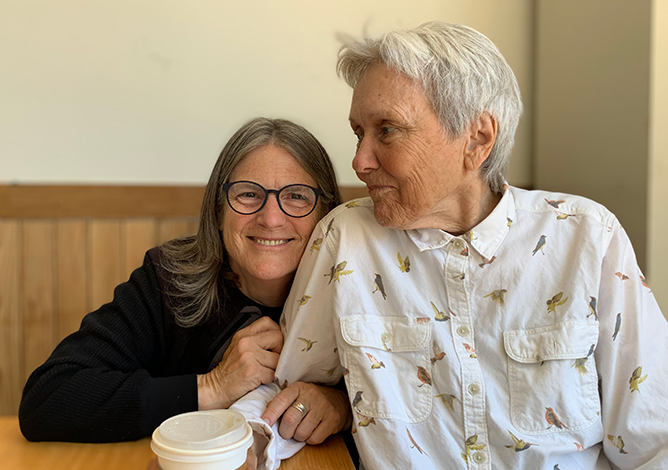
Joyce Calvert, with her wife, Jane Dahlgren who was living with Alzheimer’s disease. Photo by Rowena Richie.
I met Joyce and Jane through University of California, San Francisco’s (UCSF’s) Global Brain Health Institute (GBHI) where I was an Atlantic Fellow for Equity in Brain Health from 2018 to 2019. In the summer of 2020 I enrolled Joyce and Jane in my GBHI pilot project, For You: Creative Engagement for Dementia Dyads.
The purpose of the pilot project was to provide customized, one-on-one creative engagement to dementia dyads—family carers and their loved ones living with dementia. The aim was to mitigate dyads’ strain and isolation, exacerbated by pandemic uncertainty and vulnerability.
My methodology in working with the dyads could be called creative engagement. I began each session with a prompt, then followed the threads of participants’ creative impulses drawing on “yes-and” theater principles and my experience as a lifelong dancer and performer. The intervention culminated in a “gift” delivered to the dyad in the form of a small performance that said, “I see you. I hear you.”
Over Zoom, Joyce, Jane and I entered our “lab.” Joyce cued the music on and off we went, making it up as we went along. Follow-the-leader qigong, improvised singing, mirroring, transforming ordinary objects into extraordinary props. This was failure-free play. No impulse was too zany or too remote. Jane had a wildly fertile imagination, sense of humor and creative range. She could also be very still. We followed her lead. One session began with whistling, led to banana birds and ended with a banana duel. It was relational, reciprocal, mutually impactful.
Sometimes when the playful part of our session wound down, Joyce and I would have a heart-to-heart. Care partners were struggling. The pandemic was making their world smaller. Accelerating their loved one’s decline. Joyce often felt that she was alone in a pool—isolated, depleted, sinking.
“The pool” metaphor captured Joyce’s sense of feeling submerged. By Annie Kunjappy.
The culminating gift for Joyce and Jane was an attempt to join Joyce in the pool.
I produced a winter solstice celebration over Zoom that included a variety show featuring artists and special guests. Among these were a family of carolers who performed “Joyce to the World,” a take on “Joy to the World” customized to Joyce and Jane’s experience. Joyce said the event helped her feel seen: “I loved that people we didn’t know acknowledged us, acknowledged that dementia is lived with and is a part of the human experience.”
I wrote an essay with Joyce titled “It’s Hard To Say” that highlighted how important it was to have folks in the pool with her. It was featured in the Spring 2021 issue of In Dance.
Eventually, I climbed Bernal Hill to see Joyce and Jane in person.
Jane had been a treasured high school art teacher and prolific artist. Their home doubled as a gallery of artworks and collectibles. During one visit Joyce pulled out a handmade booklet that Jane had contributed to. A guide to living with cognitive impairment. It was stitched together by Julie Klee.
Julie Klee is grateful for every day she shared with her beloved husband, Walt. She filled journals with details of their dementia odyssey, wringing every last drop out of their blessed togetherness.
After Walt’s death Julie led a writing group for people living with cognitive impairment. Jane was in the group. One day in 2016 Julie asked them, “What do you want people to know about living with this disease?” Jane and four others opened up their notebooks and began writing. Julie assembled their words into What People Need to Know About Life With Alzheimer’s, From 5 Brave Spirits Experiencing Cognitive Impairment.
This splendid, slender booklet speaks volumes:
Don’t baby me. But try to understand. And it will all be OK.
Between pages, sheets of vellum with holes reveal momentary wisdom fragments:
explain things
-whelm me with information
day goes by
naps
This could help, I marveled.
This could move the needle.
This tactile little booklet, with mismatched edges and holes to convey the “extra sense” of Alzheimer’s, could help us “get” it. Slow down and connect.
Connect with people living with dementia. With care partners. With people who care for care partners. And, more importantly, with people who haven’t been touched by dementia. Yet.
Yes. This could help us all get dementia.
I was also struck by Julie’s use of creative engagement. Like me, she started with a prompt, followed the threads, and delivered a response that said, “I see you. I hear you.” The booklet moved me so much I wanted to create its sequel. A sequel to capture the wisdom of dementia care partners, sometimes referred to as “hidden victims of dementia” because of how overwhelming and isolating it can be. I wanted to “unhide” them.
I wanted to give voice to their pain.
But reducing the experience to one of suffering perpetuates the fear, shame and stigma narrative that surrounds dementia. Care partners had also expressed a sense of personal growth and boundless love. I wanted to capture that aspect as well.
Julie and Joyce agreed to help me make the sequel: What People Need to Know About Dementia Care, From 5 Courageous Care Companions Experiencing Their Loved One’s Cognitive Change. Together we curated a selection of writings from my collected care partner reflections. Then Julie made the booklets by hand. She used assorted textures, from velvet to sandpaper, to viscerally convey the tenderness and rough times that come with caring for someone living with cognitive impairment.
We believe the pair of booklets dovetails with a wider, growing movement to rethink dementia. The dementia narrative is beginning to shift from hopelessness alone to one that encompasses hope as well. The booklets speak a message of “stay with us, don’t forget us”—a theme in keeping with more and more calls for a dementia-inclusive society.
So we hope the booklets play a role in the public conversation. The power and wisdom in their pages cry out for broader engagement and more resources to shore up those living with dementia and their care partners.
At the same time, the booklets and the overall pilot project are personal for me. My initial impetus for the pilot was to try to alleviate the suffering I was seeing in my friends as care partners. They were isolated, overwhelmed and often despairing. I’m grateful the pilot surfaced some concrete ways to lift their spirits. And I have come to think of the booklets as mementos from all the special times we shared—Joyce, Jane, Julie, the other participants and me.
I even see the booklets as something that may help me and my aging friends should we experience dementia. They may serve as keepsakes for a time to come when we won’t remember.
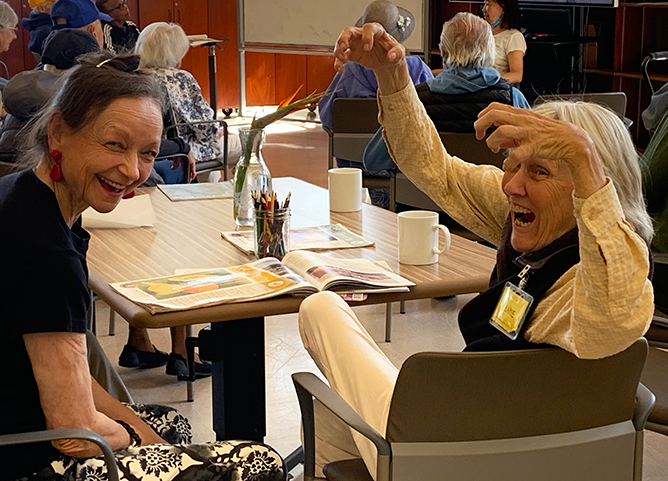
Julie Klee, left, with Jane Dahlgren in 2022. Photo by Rowena Richie.
Caring for others is part of the maturation of the human spirit. When we slow down, pool our hope and plunge into the practice of being human together there is great potential for growth. To humanize dementia is to support the fullest life possible for all of us.
It’s time to “get” dementia. In our heads. And in our hearts.
The Booklets
What People Need To Know About Life With Alzheimer’s
From 5 Brave Spirits Experiencing Cognitive Impairment
This booklet features wisdom from people living with cognitive change to point us in the right direction. The tactile pages reflect the feeling, nature, and “extra sense” of Alzheimer’s and remind us to engage with dementia through our head, hands and heart.
Read The Booklet
Listen To The Audio
Download PDF
What People Need to Know About Dementia Care
From 5 Courageous Care Companions Experiencing Their Loved One’s Cognitive Change
This booklet shares the grief and the gifts of caring for someone living with dementia. It also gives tips for navigating this rugged, sacred work. The care companions’ outlook and wisdom remind us of our fundamental wholeness.
Read The Booklet
Listen To The Audio
Download PDF
